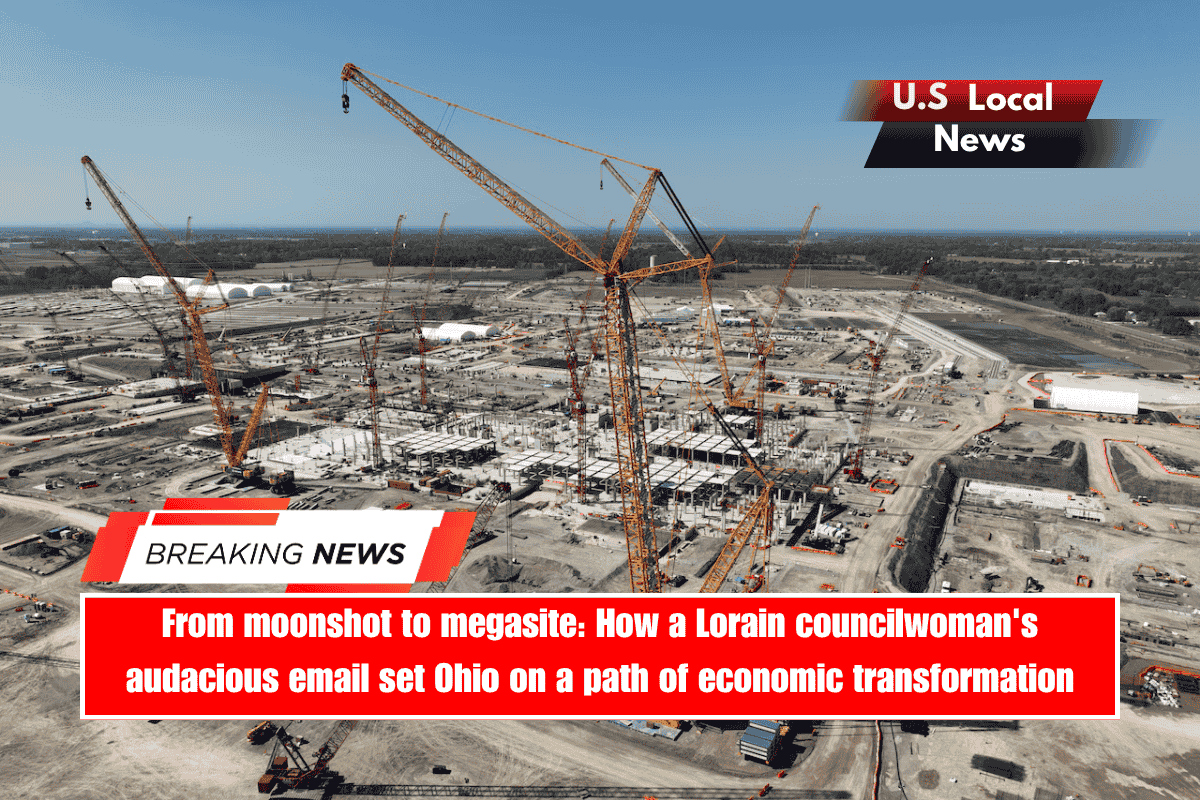Lorain, Ohio – When Lorain Councilwoman Mary Springowski sent an email to Intel’s CEO in 2021, urging the tech giant to consider building its next chip manufacturing plant in her hometown, she knew she was taking a risk.
“It was a moonshot,” Springowski told Cleveland.com. “But I had nothing to lose.”
Lorain did not win the $28 billion Intel project. However, Springowski set in motion a series of events that enabled Columbus to win the bid, promising the largest single private sector investment in state history and laying the groundwork for Lorain County’s own transformative project.
In the three and a half years since Intel’s decision, economic development leaders in Lorain County and Northeast Ohio have been preparing to be “shovel ready” for the next big opportunity. With $67 million in state funding and plans for a 1,000-acre megasite near the county airport, Lorain is closer than ever.
The email that started it all
Springowski first came up with the idea in 2020, while still working for Ford Motor Company. She had heard that United Auto Workers was considering building its own chip manufacturing plant. Lorain, she believed, was a natural fit.
“What are your manufacturing requirements? You need a lot of water. So, where better than a city located directly on the world’s largest freshwater ocean? Springowski explained. “We currently have an active port. We have a free trading zone. We have everything they need.”
Springowski contacted congressional representatives and Ford leadership, recommending that the facility be built in Lorain. No one replied.
Then, in 2021, while watching business news during pandemic downtime, her son mentioned a chip industry merger and encouraged her to try again.
This time, Springowski went straight to the top, gathering contact information for major chip company executives.
“As it turns out, you can buy anything on the internet,” Springowski explained. “So, I bought some email addresses.”
One belonged to Intel’s then-CEO, Pat Gelsinger. She revised her previous pitch, included a video presentation, and clicked send.
By the next morning, Intel had responded and invited Lorain to talk.
Within hours, Springowski was coordinating with city and county port officials. The following day, the team held a conference call with Intel, and Lorain was allowed to submit a proposal.
But there was a catch: Intel required a 1,000- to 1,500-acre shovel-ready site with a single owner, and they needed it within days.
Lorain did not have it.
“It was just unfortunate,” Springowski explained. “Getting that kind of acreage configured properly and ready in three days is a tall order.” I believe we could have met their needs, but not within that timeframe.”
Recognizing the importance of the opportunity, the Lorain group forwarded it to Team NEO, the region’s economic development partner.
Christine Nelson, Team NEO’s vice president of project management and site strategies, said she quickly saw the challenge—and an opportunity.
“Intel has had a request for information out with other states for a couple of weeks,” Nelson told Cleveland.com. “What they wanted didn’t exist in Northeast Ohio—and couldn’t be assembled in three days.”
But Nelson knew of a suitable location near Columbus. She pitched it, Intel agreed to look into it, and she brought in JobsOhio.
“We didn’t want Ohio to miss out on the opportunity to compete,” according to Nelson. “So, we turned it over to JobsOhio, and the rest is history.”
In January 2022, Gov. Mike DeWine announced Intel’s decision to build the new facility in New Albany, a suburb about 20 minutes northeast of Columbus. DeWine stated that the project was expected to create 3,000 direct jobs with an average salary of $135,000, as well as thousands more in the construction and supporting industries.
Nelson credits Lorain’s initiative with setting things in motion.
“I have so much respect for Councilwoman Springowski and Lorain County for being able to see that this was something that needed a bigger team,” Nelson pointed out. “Economic development is a team sport, and in this instance, we landed a project impactful for the entire state.”
The road to Lorain County’s mega site
Rather than focusing on what could have been, Springowski found validation in the outcome. Her “moonshot” had demonstrated that her vision was not unrealistic; it simply required better planning and timing.
“It was very gratifying that it wasn’t a crazy idea,” she told me. “Everyone always says ‘we should do this’ and ‘we should do that,’ but nothing ever happens. I’m not that type of person. “I’ll just go out and do it.”
The Intel experience was a catalyst for change in Lorain County. Economic development officials vowed to be ready the next time.
“I don’t care what community you put it in, thousands of jobs is huge,” said Karen Perkins, a county development official. “Being able to prepare for such a large development was a valuable learning experience for us. We decided we’d be ready the next time.”
Team NEO had been looking into potential industrial sites throughout the region for years, but the Intel discussion brought Lorain County to the forefront. Marcia Ballinger, president of Lorain County Community College and a Team NEO board member, suggested looking into land near Lorain County Regional Airport.
The more Team NEO investigated the land, the more potential they found. According to Nelson, the location is convenient for the workforce, existing infrastructure, and public transportation. It is strategically located in the triangle formed by Oberlin, Elyria, and Lorain, with easy access to major population centers in Cuyahoga and Medina counties within 45 minutes.
Perkins stated that while the regional partners have done a lot of the legwork to find a developer or company interested in the site, the Lorain County team has been working in the background on logistics.
With the recently announced $67.4 million in funding from Ohio’s All Ohio Future Fund, the project can now focus on upgrading critical infrastructure around the site, which has limited business development potential. Plans call for an extended runway as well as industrial-scale water and sewer capacity, possibly supplemented by a new wastewater treatment facility.
Earlier this year, Intel announced that its New Albany factory, which was supposed to open in 2025, would not open until 2030 or 2031 due to financial difficulties, Gelsinger’s departure, and issues with receiving $1.5 billion in federal CHIPS Act funds.
Last month, The Columbus Dispatch reported that construction had slowed even more.
If and when the plant opens, it may not be owned by Intel. According to media reports, company officials are considering selling off its entire chip manufacturing business.
Meanwhile, Lorain County is moving ahead with its mega-site plans. Springowski remains optimistic about the site’s potential to spur development and change lives throughout the region.
“I’m always preaching economic development,” she told me. “But I don’t want another pizzeria. I do not want another retail store. I want meaningful economic development—the kind that pays a living wage and makes a real difference.”









